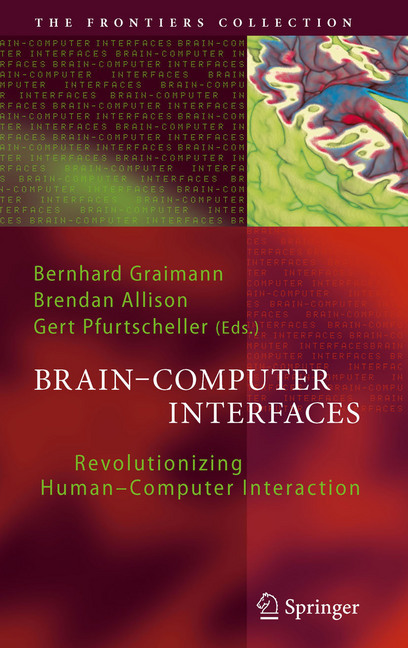Brain-Computer Interfaces
Revolutionizing Human-Computer Interaction
A brain-computer interface (BCI) establishes a direct output channel between the human brain and external devices. BCIs infer user intent via direct measures of brain activity and thus enable communication and control without movement. This book, authored by experts in the field, provides an accessible introduction to the neurophysiological and signal-processing background required for BCI, presents state-of-the-art non-invasive and invasive approaches, gives an overview of current hardware and software solutions, and reviews the most interesting as well as new, emerging BCI applications. The book is intended not only for students and young researchers, but also for newcomers and other readers from diverse backgrounds keen to learn about this vital scientific endeavour.
1;Preface;6 2;Contents;8 3;Contributors;10 4;List of Abbreviations;14 5;BrainComputer Interfaces: A Gentle Introduction;16 5.1;1 What is a BCI?;17 5.2;2 How Do BCIs Work?;20 5.2.1;2.1 Measuring Brain Activity (Without Surgery);21 5.2.2;2.2 Measuring Brain Activity (With Surgery);22 5.2.3;2.3 Mental Strategies and Brain Patterns;24 5.2.3.1;2.3.1 Selective Attention;25 5.2.3.2;2.3.2 Motor Imagery;26 5.2.4;2.4 Signal Processing;28 5.3;3 BCI Performance;29 5.4;4 Applications;31 5.5;5 Summary;37 5.6;References;39 6;Brain Signals for BrainComputer Interfaces;43 6.1;1 Introduction;43 6.1.1;1.1 The Need for BCIs;43 6.1.2;1.2 Key Principles;43 6.1.3;1.3 The Origin of Brain Signals Used in BCIs;44 6.2;2 Brain Signals for BCIs and Their Neurophysiological Origins;45 6.2.1;2.1 Brain Signal Features Measured Noninvasively;46 6.2.1.1;2.1.1 Event-related Potentials (ERPs);46 6.2.1.2;2.1.2 Cortical Oscillations;49 6.2.2;2.2 Brain Signal Features Measured from the Cortical Surface;51 6.2.3;2.3 Brain Signal Features Measured Within the Cortex;51 6.2.3.1;2.3.1 Local Field Potentials (LFPs) in the Time Domain;52 6.2.3.2;2.3.2 Local Field Potentials in the Frequency Domain;52 6.2.3.3;2.3.3 Single-Neuron Activity;52 6.3;3 Requirements for Continued Progress;53 6.4;References;54 7;Dynamics of Sensorimotor Oscillations in a Motor Task;61 7.1;1 Introduction;61 7.2;2 EventRelated Potentials Versus ERD/ERS;62 7.3;3 Mu and Beta ERD in a Motor Task;62 7.4;4 Interpretation of ERD and ERS;65 7.5;5 Focal ERD/Surround ERS;66 7.6;6 Induced Beta Oscillations after Termination of a Motor Task;67 7.7;7 Short-Lived Brain States;69 7.8;8 Observation of Movement and Sensorimotor Rhythms;71 7.9;9 Conclusion;73 7.10;References;73 8;Neurofeedback Training for BCI Control;79 8.1;1 Introduction;79 8.2;2 Principles of Neurofeedback;80 8.2.1;2.1 Training of Sensorimotor Rhythms;81 8.2.2;2.2 How Neurofeedback Works;82 8.3;3 Training Paradigms for BCI Control;82 8.3.1;3.1 Training with the Graz-BCI;83 8.3.2;3.2 Impact of Feedback Stimuli;85 8.4;4 Final Considerations;87 8.5;References;89 9;The Graz Brain-Computer Interface;93 9.1;1 Introduction;93 9.2;2 The Graz BCI;93 9.3;3 Motor Imagery as Mental Strategy;95 9.3.1;3.1 Induced Oscillations in Non-attended Cortical Body Part Areas;96 9.3.2;3.2 Induced Beta Oscillations in Attended Cortical Body Part Areas;97 9.3.3;3.3 The Beta Rebound (ERS) and its Importance for BCI;98 9.4;4 Feature Extraction and Selection;99 9.5;5 Frequency Band and Electrode Selection;101 9.6;6 Special Applications of the Graz BCI;102 9.6.1;6.1 Self-Paced Exploration of the Austrian National Library;102 9.6.2;6.2 Simulation of Self-Paced Wheel Chair Movement in a Virtual Environment;103 9.6.3;6.3 Control of Google Earth;105 9.7;7 Future Aspects;106 9.8;References;107 10;BCIs in the Laboratory and at Home: The WadsworthResearch Program;111 10.1;1 Introduction;111 10.2;2 Sensorimotor Rhythm-Based Cursor Control;112 10.3;3 P300-Based Item Selection;116 10.4;4 A BCI System for Home Use;120 10.5;5 SMR-Based Versus P300-Based BCIs;121 10.6;References;123 11;Detecting Mental States by Machine Learning Techniques: The Berlin BrainComputer Interface;126 11.1;1 Introduction;126 11.1.1;1.1 The Machine Learning Approach;126 11.1.2;1.2 Neurophysiological Features;127 11.1.2.1;1.2.1 Readiness Potential;128 11.1.2.2;1.2.2 Sensorimotor Rhythms;129 11.2;2 Processing and Machine Learning Techniques;129 11.2.1;2.1 Common Spatial Patterns Analysis;130 11.2.2;2.2 Regularized Linear Classification;131 11.2.2.1;2.2.1 Mathematical Part;131 11.3;3 BBCI Control Using Motor Paradigms;133 11.3.1;3.1 High Information Transfer Rates;133 11.3.2;3.2 Good Performance Without Subject Training;135 11.3.3;3.3 BCI Illiteracy;136 11.4;4 Applications of BBCI Technology;138 11.4.1;4.1 Prosthetic Control;138 11.4.2;4.2 Time-Critical Applications: Prediction of Upcoming Movements;139 11.4.3;4.3 Neuro Usability;140 11.4.4;4.4 Mental State Monitoring;141 11.4.4.1;4.4.1 Experimental Setup for Atten
Graimann, Bernhard
Pfurtscheller, Gert
Allison, Brendan Z.
| ISBN | 9783642020919 |
|---|---|
| Artikelnummer | 9783642020919 |
| Medientyp | E-Book - PDF |
| Copyrightjahr | 2010 |
| Verlag | Springer-Verlag |
| Umfang | 397 Seiten |
| Sprache | Englisch |
| Kopierschutz | Digitales Wasserzeichen |








